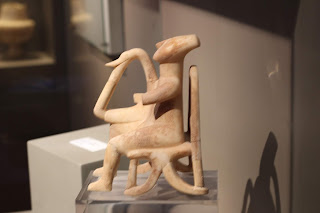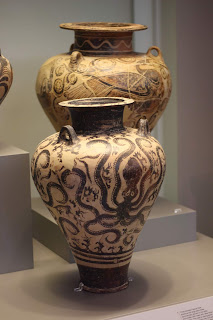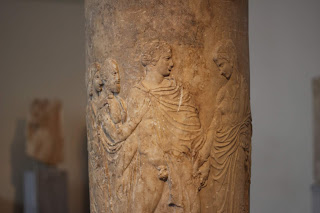When I first started travel-blogging, a number of years ago, the idea was to do a detailed travel diary, illustrated with a few pictures. That got to be too much work. Nowadays, this blog is mostly a lot of photographs, with some text primarily designed to explain the pictures.
On Wednesday, June 6th, we checked out of the Acropolis Select and got on a bus, where we met our driver, Costas, and rode to the National Archaeological Museum. Faye was there, waiting for us, and took us inside.
This is a great collection, with some striking pieces. The centerpiece is the group of priceless objects that Heinrich Schliemann found in the tombs at Mycenae, including the golden "Mask of Agamemnon" (though Agamemnon, if he existed, would have lived three centuries after the man buried with this death mask). Particularly wonderful are two large bronze statues. Most ancient bronzes did not survive into modern times: bronze is valuable and can be melted down to make other things. The museum's statue of the sea-god Poseidon (or maybe Zeus) was found in the sea, in an ancient shipwreck. The statue, from the classical period (fifth century B.C) depicts the god, the size of a very tall, very well-built mortal, about to throw his (missing) trident.
Another bronze piece found in the sea is the marvelous Hellenistic (second century B.C.) boy jockey on a horse. Here is not the otherworldly calm of the Poseidon statue. Horse and rider are caught, for a split-second, in frantic action, in the middle of a race, which they seem to be winning, but not handily.
Wandering around the museum on our own, we visited the Minoan room, where there are wall frescoes and other objects from the city of Akrotiri, buried by the enormous volcanic eruption that destroyed the island of Santorini, around 1630 B.C.
We said goodbye to Faye and got on the bus to drive to Delphi. On the way we stopped for lunch at a roadside restaurant, where Mary Joy and I had pizza.
On arrival at Delphi, we checked into the Hotel Leto, then walked in a group to the Archaeological Museum, where we met our local guide, Penny. She took us through the museum, which is relatively small. The most interesting piece is a bronze statue of a charioteer, from the fifth century, B.C,, which apparently avoided being melted down by being buried under rubble in ancient times.
Penny then led us up to the sanctuary of Apollo, the reason why Delphi existed--it wasn't really a town. Here the Oracle, in a trance, gave answers to questions posed to Apollo, including matters of great concern to rulers of nations.
After Penny said goodbye, Mary Joy and I went up to the theater, then all the way up to the stadium.
Dinner at the Taverna Vakhos was very good.
On Wednesday, June 6th, we checked out of the Acropolis Select and got on a bus, where we met our driver, Costas, and rode to the National Archaeological Museum. Faye was there, waiting for us, and took us inside.
This is a great collection, with some striking pieces. The centerpiece is the group of priceless objects that Heinrich Schliemann found in the tombs at Mycenae, including the golden "Mask of Agamemnon" (though Agamemnon, if he existed, would have lived three centuries after the man buried with this death mask). Particularly wonderful are two large bronze statues. Most ancient bronzes did not survive into modern times: bronze is valuable and can be melted down to make other things. The museum's statue of the sea-god Poseidon (or maybe Zeus) was found in the sea, in an ancient shipwreck. The statue, from the classical period (fifth century B.C) depicts the god, the size of a very tall, very well-built mortal, about to throw his (missing) trident.
Another bronze piece found in the sea is the marvelous Hellenistic (second century B.C.) boy jockey on a horse. Here is not the otherworldly calm of the Poseidon statue. Horse and rider are caught, for a split-second, in frantic action, in the middle of a race, which they seem to be winning, but not handily.
Wandering around the museum on our own, we visited the Minoan room, where there are wall frescoes and other objects from the city of Akrotiri, buried by the enormous volcanic eruption that destroyed the island of Santorini, around 1630 B.C.
We said goodbye to Faye and got on the bus to drive to Delphi. On the way we stopped for lunch at a roadside restaurant, where Mary Joy and I had pizza.
On arrival at Delphi, we checked into the Hotel Leto, then walked in a group to the Archaeological Museum, where we met our local guide, Penny. She took us through the museum, which is relatively small. The most interesting piece is a bronze statue of a charioteer, from the fifth century, B.C,, which apparently avoided being melted down by being buried under rubble in ancient times.
Penny then led us up to the sanctuary of Apollo, the reason why Delphi existed--it wasn't really a town. Here the Oracle, in a trance, gave answers to questions posed to Apollo, including matters of great concern to rulers of nations.
After Penny said goodbye, Mary Joy and I went up to the theater, then all the way up to the stadium.
Dinner at the Taverna Vakhos was very good.
















































































No comments:
Post a Comment